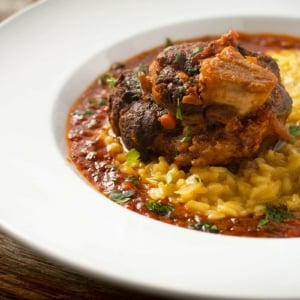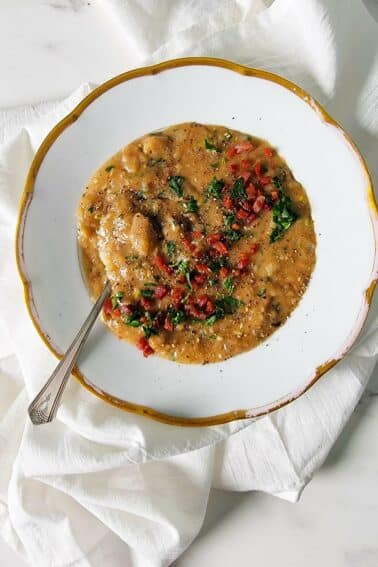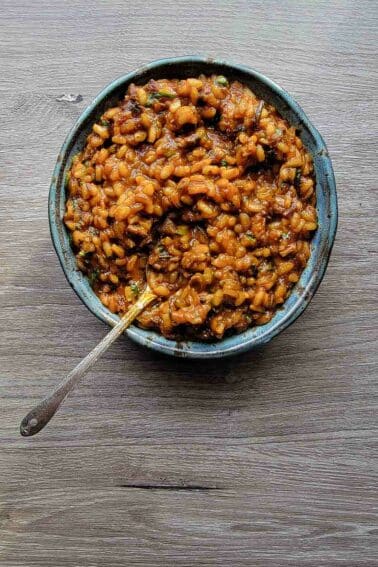As an Amazon Associate I earn from qualifying purchases.
Ossobuco, if you are not familiar with it, is a Northern Italian classic: Braised shank with a tomato sauce, usually served with risotto, which makes it ossobuco milanese. To make it right, you need the shank of a large animal, like beef. This is an elk osso buco.
Beef or veal shank is traditional, and pork shank is common, too. I’ve seen it with little lamb shanks occasionally. But I mostly make ossobuco, which means “bone with a hole” in Italian, with shanks from larger animals.

Making ossobuco milanese is straightforward: Dust the shanks in flour, brown in olive oil or butter (or lard), sauté veggies and braise until tender with white wine and tomato sauce. A veal shank might take 2 hours; elk osso buco might take 4 hours.
And you don’t need to serve it with risotto, although that is what makes it a proper ossobuco milanese. Polenta is a great alternative, as is a loaf of good, crusty bread. Just don’t forget the red wine at the table.
You will have more sauce here than you need for this meal. My advice is to use it as a pasta sauce, maybe with homemade squash gnocchi. And if you have leftover meat, shred it up and use it as a filling for homemade agnolotti.
Any sort of shank will work here. One important tip on dealing with large shanks: Use kitchen twine to tie them tightly while cooking — this keeps them together and compact. Mostly it’s for presentation, but if you skip this step you run the risk of the shanks falling apart in your sauce. Not always a bad thing.
I’ve seen, very rarely, ossobuco milanese made with oxtail. It’s not traditional, but the cuts of meat are very similar, so if you have that, go for it.
A note for hunters, who will be cutting their own shanks for ossobuco: Use a knife to slice the shank meat to the bone, making each cross cut about three fingers’ thick. Then use a hacksaw or Sawzall to cut through the bone. Wipe any bone debris away with a cloth or paper towel.
If you are making osso buco from smaller animals, like small deer, javelina or smaller pigs, leave the shanks whole.
One nice, and very traditional, option for topping your ossobuco milanese is to make a quick gremolata, which is minced Italian parsley, fresh garlic and lemon zest. A good ratio is 1 large garlic clove, 1/4 cup minced parsley and 1 or 2 tablespoons minced lemon zest. This brightens things up a lot.
Ossobuco Milanese
Ingredients
- 4 cross-cut shanks, about 2-3 inches thick
- Salt
- Flour for dusting
- 1/4 cup olive oil, butter or bear fat
- 1 onion, chopped
- 2 carrots, chopped
- 2 celery stalks, chopped
- 1/2 ounce dried porcini mushrooms about a handful, chopped
- 1 cup white wine
- 1 cup chicken, beef or game stock
- 1 28- ounce can crushed tomatoes
- 1 teaspoon dried thyme
- 1 teaspoon dried oregano
- Zest of a lemon cut into large strips, white pith removed
- 2 bay leaves
- 1/4 cup chopped fresh parsley, for garnish
Instructions
- Preheat the oven to 300°F. Heat the olive oil in a Dutch oven or other large pot set over medium-high heat. Salt the shanks well and dust them in the flour to coat. Brown them well in the pot. Take your time and get a good browning on them, which should take a solid 10 minutes. Remove and set aside.
- Add the onion, carrot, celery and porcini mushrooms, and sauté until slightly browned around the edges, about 6 to 8 minutes. Sprinkle some salt on them as they cook.
- Pour in the white wine and use a wooden spoon to scrape up any browned bits on the bottom of the pot. When this comes to a boil, add the stock, crushed tomatoes, thyme, oregano, lemon zest and bay leaves and bring to a simmer. Return the shanks to the pot and turn to coat with the sauce. Cover the pot and move it to the oven. Cook until tender, between 2 and 4 hours, depending on the animal. Serve on top of risotto or polenta, or alongside some bread, garnished with the parsley.
Notes
Nutrition
Nutrition information is automatically calculated, so should only be used as an approximation.






I’m thinking of taking a similar approach to a whole antelope shoulder. Yay or nay?
Luke: It’ll work flavorwise, although the presentation will be different.
Made Mooso buco last week from Lidia Badstianich’s recipe, served over polenta, just wonderful. The shanks weighed about 2-3 lbs, used two pieces. after 2.5 hours the meat had seized up, it was terrible, like a rock. Put it back in for another 3 hours, perfection!
What white wine to recommend for this recipe?
Garret: A full bodied, rich one. Maybe a Cotes du Rhone blend?
I made this recipe this week with axis deer shanks, and it turned out wonderful just like every other recipe from Hank Shaw’s recipe files.
Awesome recipe Hank. The bear shanks will be labelled accordingly from now on.
Made this with a 3 – 4 lb bear shank.
It was awesome. The meat was cut with a fork tender….so good.
Great recipe for that part of the bear.
Hi Hank,
I have a whole bear shank from the front leg.
It’s about 3-4 lbs and I’m wondering if you think it will work in osso bucco without cutting it into smaller pieces?
It’s almost more like leg of lamb.
Thanks
Hunhtr: It will work fine — if you can get the shank into a pot!
What a delicious sounding recipe!
Wanted to share with you that I have had wonderful meals of osso buco cooked in a pressure cooker. Talk about fork-tender meat that falls off the bone…yum! And food cooks faster in a p.c.. Today’s pressure cookers are WAY safer and easier to use than those from 20+ years ago, too.
I put a little oil in the pan first, brown the meat on all sides, then add broth, spices, herbs and whatnot – actually after reading your delicious sounding recipe I am tempted to try that.
Wow! I love your site. Deerslayer brought home his second nilgai. This time, as we processed the meat, we set aside the femurs for making stock and the shanks for osso buco. I came across your blog by way of Andy Spencer. I’m glad I did.
I just found your site, and am very pleased to learn new recipes for Bear. We got a nice spring Bear this year, and made “corned beef” with the belly. As you said, harvesting the right animal is very important for clean, good tasting meat. Thanks for your sharing.
Wow… now I have to find the right shanks here to make “osso bucco” again. It will probably end up being pork, but beggars can’t be choosers.
However, I love my osso bucco with puy lentils….Yummy!
I’m not sure what bears are like in California, however up here in western canada bears spend lot of time eating dandelions in heavily pesticided ditches beside roads and train tracks. Couple that with the fact that they are scavengers who will gladly eat human garbage…. I just can’t get excited about eating bear…
No gremmolata?
funny article!!
but it also looks really good
I’m betting this would work most excellently with the Beef short ribs I get from the local Mexican/Latin market….
Orso bucco
Absolutely brilliant, sir! LOL
I recently made “osso bucko” with venison, I love the name “orso buco.”
Hi hank, I have been a lurker and avid follower of your blog for a long time now, and love your writing, and have used your recipes as a great source of inspiration. However, I am quite disappointed that the “Gardener” aspect of “Hunter-Angler-Gardener-Cook” has been neglected for so long. Pleeaase get back into the garden 🙂
Don’t know if you remember but Osso Buco was Frank’s favorite dish. Several restaurants would let him know in advance when they were going to make it so he could be sure and get one of the few servings made. I’m sure none were ever made with bear though. Bet he would have enjoyed eating your version.
I love your site—where else would I come across a recipe for Black Bear? Putting these rich shanks over risotto is a wonderful idea, I’m going to try that next time I make short ribs.